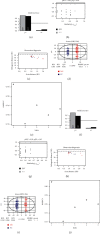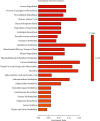Flos Carthami Exerts Hepatoprotective Action in a Rat Model of Alcoholic Liver Injury via Modulating the Metabolomics Profile
- PMID: 35547657
- PMCID: PMC9085312
- DOI: 10.1155/2022/8158699
Flos Carthami Exerts Hepatoprotective Action in a Rat Model of Alcoholic Liver Injury via Modulating the Metabolomics Profile
Abstract
This study was intended to identify the shifts in the metabolomics profile of the hepatic tissue damaged by alcohol consumption and verify the potential restorative action of flos carthami (the flowers of Carthamus tinctorius, FC) in the protection of alcohol-induced injury by attenuating the level of identified metabolites. Rats were treated with FC and subsequently subjected to alcohol administration. The serum samples were subjected to liquid chromatography-mass spectrometry (LC-MS)-based metabolomics followed by statistical and bioinformatics analyses. The clustering of the samples showed an obvious separation in the principal component analysis (PCA) plot, and the scores plot of the orthogonal partial least squares-discriminant analysis (OPLS-DA) model allowed the distinction among the three groups. Among the 3211 total metabolites, 1088 features were significantly different between the control and alcohol-treated groups, while 367 metabolites were identified as differential metabolites between the alcohol- and FC-treated rat groups. Time series clustering approach indicated that 910 metabolites in profile 6 were upregulated by alcohol but subsequently reversed by FC treatment; among them, the top 10 metabolites based on the variable importance in projection (VIP) scores were 1-methyladenine, phenylglyoxylic acid, N-acetylvaline, mexiletine, L-fucose, propylthiouracil, dopamine 4-sulfate, isoleucylproline, (R)-salsolinol, and monomethyl phthalate. The Pearson correlation analysis and network construction revealed 96 hub metabolites that were upregulated in the alcohol liver injury model group but were downregulated by FC. This study confirmed the hepatoprotective effects of FC against alcohol-induced liver injury and the related changes in the metabolic profiles, which will contribute to the understanding and the treatment of alcohol-induced acute liver injury.
Copyright © 2022 Xiaojing Fan et al.
Conflict of interest statement
The authors declare that there are no conflicts of interest regarding the publication of this paper.
Figures








Similar articles
-
Investigation of the Hepatoprotective Effect of Prunus mume Sieb. et Zucc Extract in a Mouse Model of Alcoholic Liver Injury Through High-Resolution Metabolomics.J Med Food. 2017 Aug;20(8):734-743. doi: 10.1089/jmf.2016.3874. Epub 2017 Jun 26. J Med Food. 2017. PMID: 28650205
-
Anoectochilus roxburghii polysaccharide prevents carbon tetrachloride-induced liver injury in mice by metabolomic analysis.J Chromatogr B Analyt Technol Biomed Life Sci. 2020 Sep 1;1152:122202. doi: 10.1016/j.jchromb.2020.122202. Epub 2020 Jun 2. J Chromatogr B Analyt Technol Biomed Life Sci. 2020. PMID: 32534261
-
Mechanisms of Ardisia japonica in the Treatment of Hepatic Injury in Rats Based on LC-MS Metabolomics.Metabolites. 2022 Oct 17;12(10):981. doi: 10.3390/metabo12100981. Metabolites. 2022. PMID: 36295883 Free PMC article.
-
Serum Metabolomics Study of Papillary Thyroid Carcinoma Based on HPLC-Q-TOF-MS/MS.Front Cell Dev Biol. 2021 Feb 1;9:593510. doi: 10.3389/fcell.2021.593510. eCollection 2021. Front Cell Dev Biol. 2021. PMID: 33598460 Free PMC article.
-
A Study on Gentiana dahurica Fisch Ethanol Extract Alleviating Alcoholic Liver Disease in Mice: A Metabolomic Analysis of the Liver.Evid Based Complement Alternat Med. 2021 Jun 29;2021:5569538. doi: 10.1155/2021/5569538. eCollection 2021. Evid Based Complement Alternat Med. 2021. PMID: 34257684 Free PMC article.
Cited by
-
Mechanism of the Effect of Compound Anoectochilus roxburghii (Wall.) Lindl. Oral Liquid in Treating Alcoholic Rat Liver Injury by Metabolomics.Drug Des Devel Ther. 2023 Nov 15;17:3409-3428. doi: 10.2147/DDDT.S427837. eCollection 2023. Drug Des Devel Ther. 2023. PMID: 38024538 Free PMC article.
-
Efficacy of Rhamnus utilis Decne. Aqueous extract in mice with acute alcoholic liver injury and metabolomic study.Heliyon. 2024 Jun 6;10(12):e32523. doi: 10.1016/j.heliyon.2024.e32523. eCollection 2024 Jun 30. Heliyon. 2024. PMID: 38952369 Free PMC article.
-
Study on the mechanism of hepatotoxicity of Aucklandiae radix through liver metabolomics and network pharmacology.Toxicol Res (Camb). 2024 Aug 7;13(4):tfae123. doi: 10.1093/toxres/tfae123. eCollection 2024 Aug. Toxicol Res (Camb). 2024. PMID: 39119266 Free PMC article.
References
LinkOut - more resources
Full Text Sources

